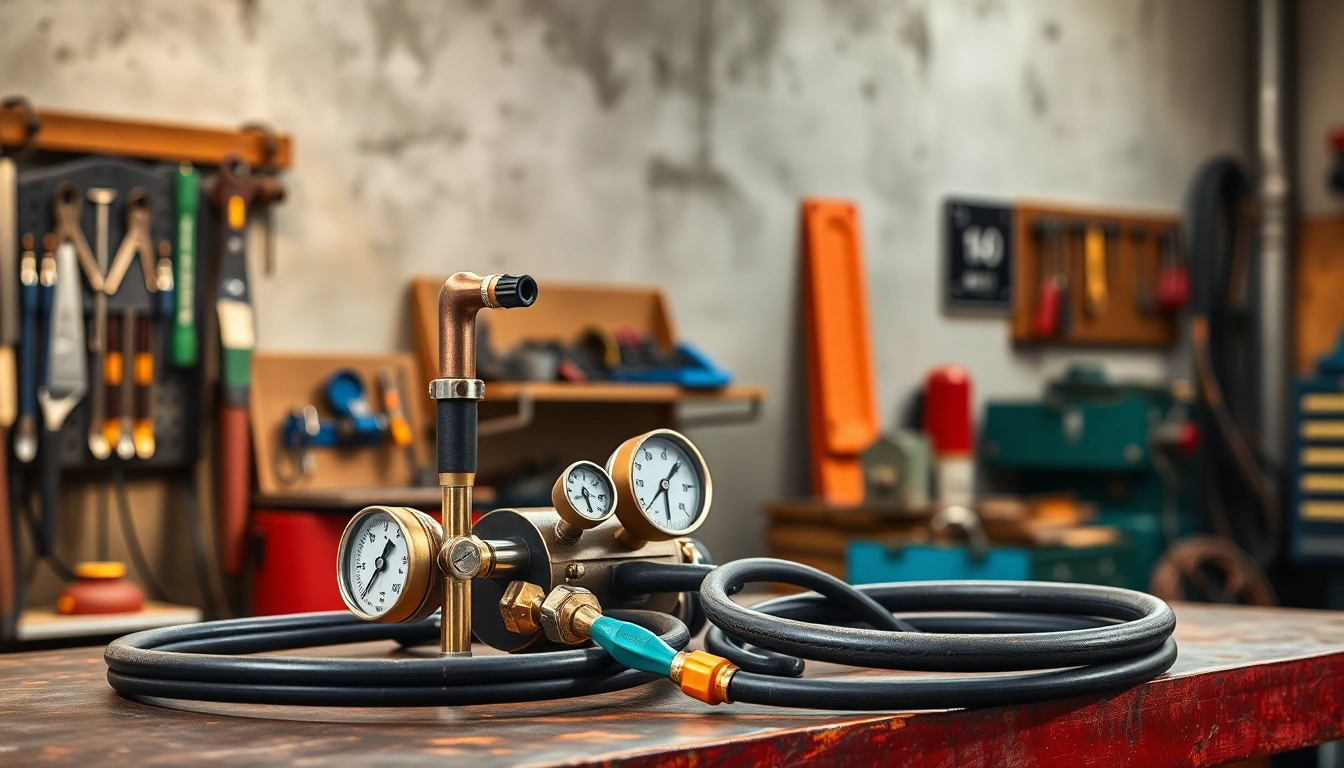Introduction to Oxy Acetylene Welding Kits
If you’re looking to engage in various welding projects, an oxy acetylene welding kit may be your best bet. This traditional method of welding utilizes the combustion of oxygen and acetylene gases to produce a flame hotter than 3,500 degrees Fahrenheit, making it ideal for a range of applications—from metalwork and plumbing to motor vehicle repairs and artistic metal sculptures. This guide covers the essential components, considerations for choosing a kit, best practices for usage, maintenance tips, and more, ensuring you’re equipped with a comprehensive understanding of oxy acetylene welding kits.
What is an Oxy Acetylene Welding Kit?
An oxy acetylene welding kit consists of a combination of equipment designed to facilitate the welding and cutting of various metals. The main principle behind this process is the reaction between oxygen and acetylene gas, which ignites to form a high-temperature flame. This flame can then be directed onto metal surfaces to create a molten pool, which cools and hardens to create a strong bond. Typical users of these kits range from hobbyists and DIY enthusiasts to professional welders and industrial users.
Key Components of a Welding Kit
Understanding the fundamental components of an oxy acetylene welding kit is crucial for effective setup and operation. The typical kit includes:
- Tanks: Oxygen and acetylene tanks are essential components that store gases under high pressure.
- Regulators: Each tank is equipped with a regulator that controls the flow and pressure of the gases.
- Hoses: These flexible tubes transport gas from the tanks to the torch. Different colors (usually green for oxygen and red for acetylene) help prevent mix-ups.
- Welding Torch: This is the tool that mixes the gases and ignites them to produce the flame.
- Nozzles: These dictate the type and size of the flame produced, influenced by the welding task at hand.
- Protective Equipment: Essential items like goggles, gloves, and aprons are necessary to protect the welder from intense light and heat.
Benefits and Applications of Oxy Acetylene Welding
The benefits of oxy acetylene welding are numerous, making it a popular choice in various sectors. Here are some key advantages:
- Versatility: This method can be used for welding, cutting, brazing, and soldering, allowing for a range of applications.
- Portability: Since the equipment can be transported relatively easily, it’s ideal for on-site jobs.
- Cost-effectiveness: Compared to electric welding methods, oxy acetylene can be more economical, especially for small– to medium-sized projects.
- High Heat Output: The flame temperature can exceed 3,500°F, enabling welding on thick materials and providing versatility in applications.
Choosing the Right Oxy Acetylene Welding Kit
Selecting the ideal oxy acetylene welding kit involves considering several factors to ensure you have the right tools for your specific needs.
Factors to Consider When Selecting a Kit
Before purchasing a welding kit, evaluate these crucial aspects:
- Project Scope: Determine the types of projects you’ll undertake. Heavy-duty kits may be necessary for industrial applications, while lighter kits could suffice for hobbyist tasks.
- Welding Techniques: The techniques you plan to implement (e.g., cutting vs. welding) can influence the type of nozzles and accessories you need in your kit.
- Gas Tank Size: Larger tanks might seem advantageous for extended projects; however, consider portability and the complexity of transporting heavier tanks.
- Brand Reputation: Opt for well-known brands recognized for quality and durability to make a more reliable investment.
- Price Point: Establish a budget. Compare various kits at your price point, keeping in mind that investing in quality typically yields better long-term results.
Comparison of Popular Brands and Models
When it comes to oxy acetylene welding kits, several brands stand out due to their reliability, user reviews, and specifications. Brands like Harris, Victor, and Unimig are reputable in the market. For example:
- Harris HMD Medium Duty Ironworker: Ideal for light to medium welding tasks, priced reasonably at $99, suitable for beginner to intermediate users.
- Unimig UMC-17: A premium choice known for its durability and performance at higher capacities, designed for users who demand more.
- Victor Performer Kits: Known for their efficiency and advanced features, perfect for both learners and professional welders.
Beginner vs. Professional Kits: What’s Best for You?
Understanding the distinction between beginner and professional kits can help you choose appropriately based on your experience and project requirements:
- Beginner Kits: These are generally more affordable and include the essential components needed to start welding. They are suitable for light projects and will usually come with basic instructions.
- Professional Kits: These kits are designed for extensive use, equipped with advanced features, larger tanks, and accessories aimed at complex welding tasks.
How to Properly Use an Oxy Acetylene Welding Kit
Knowing how to use your oxy acetylene welding kit correctly is paramount for producing quality welds and ensuring safety.
Setup Process and Safety Checks
When preparing to use your kit, follow these steps:
- Inspect Equipment: Always check hoses, regulators, and tanks for leaks or damage before beginning.
- Secure Tanks: Ensure that your tanks are securely fastened to prevent them from tipping over.
- Regulator Settings: Adjust the regulators according to the recommended settings for your particular welding task.
- Attach Hoses and Nozzles: Carefully connect the hoses to the regulators and the torch, ensuring color codes are matched.
- Materials Preparation: Clean the metal surfaces you plan to weld or cut. Rust, dirt, or oil can affect the quality of the weld.
Operating Techniques for Effective Welding
Effective welding requires not just the right equipment but also sound techniques. Consider these guidelines for successfully using your oxy acetylene welding kit:
- Flame Types: Use the correct flame settings—neutral, carburizing, or oxidizing—for your specific welding application.
- Welding Position: Maintain a comfortable stance and position your body to direct the flame accurately without fatigue.
- Travel Speed: Control the speed at which you move the torch. Too fast may yield weak welds, while too slow can produce excessive heat and distorting.
Common Mistakes to Avoid
As with any skill, there are common pitfalls that novice welders might encounter. Here are some mistakes to avoid:
- Ignoring Safety: Never skip safety gear, even for quick jobs. Proper protection is crucial.
- Incorrect Flame Settings: Always adjust the flame to match your application. Using the wrong flame can ruin your work.
- Poor Preparation: Failing to properly clean and prepare metal surfaces can lead to weak joints.
Maintenance and Care for Your Welding Kit
Taking proper care of your oxy acetylene welding kit will extend its lifespan and ensure consistent performance.
Routine Maintenance Tasks
To keep your welding kit in optimal condition, perform these maintenance tasks regularly:
- Check for Leaks: Regularly inspect hoses and fittings for leaks, which can be dangerous.
- Cleansing Nozzles: Clean the nozzle tips after each use to prevent clogs that can hinder performance.
- Tighten Connections: Ensure all connections are tight to prevent gas leaks.
Storage Tips to Extend Lifespan
Appropriate storage practices can also enhance the longevity of your welding kit:
- Store in a Dry Area: Keep your set away from moisture to avoid rusting and degradation of materials.
- Lay Flat: Store hoses flat and avoid kinking to prevent damage.
- Secure Tanks: Always store gas tanks in an upright position and secured to prevent them from toppling over.
Troubleshooting Common Issues
Inevitably, problems may arise in the use of an oxy acetylene welding kit. Here are some common issues and their solutions:
- No Flame: Check if the gas valves are open and ensure the hoses are connected correctly.
- Flame Too Large or Small: This can often be adjusted through the regulator settings—ensure each tank’s pressure is correctly set.
- Backfire Issues: Clean the torch tip and ensure the proper gas mixture to reduce backfire occurrences.
Conclusion and Further Resources
In summary, understanding oxy acetylene welding kits equips you with the knowledge to engage safely and effectively in various projects. Be sure to consider factors such as project scope and budget when choosing a kit, and practice safe operating techniques for the best outcomes.
Recap of Key Points
This guide has covered a range of topics, from what an oxy acetylene welding kit entails to how to maintain it correctly. By ensuring regular inspections and proper handling, you can achieve excellent results.
Recommended Further Reading and Training
To deepen your knowledge, look for relevant online courses, local workshops, or instructional videos on oxy acetylene welding. Books and community forums can also offer insights from fellow welding enthusiasts.
Where to Buy Quality Oxy Acetylene Welding Kits
Reputable retailers like Harris, Amazon, and specialized welding supply stores are great places to purchase quality oxy acetylene welding kits. Always compare products and read reviews to ensure you make a wise investment.



